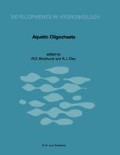Abstract
A comparative study of naidid subfamilies shows that a combination of ordination, Jaccard/Average Linkage cluster analysis and Wagner parsimony provides a useful basis for a rational phylogeny but that this does not differ markedly from the original proposed by Sperber nearly four decades ago. Hennig rules, modified by Wiley, permit a preliminary phylogeny and classification of the Annelida to be made by hand. An error in earlier versions suggested that the Dorydrilidae lacked prostate glands, and this is corrected.
Access this chapter
Tax calculation will be finalised at checkout
Purchases are for personal use only
Preview
Unable to display preview. Download preview PDF.
References
Banfield, C. F. &J. C. Gower, 1980. A note on the graphical representation of multivariate binary data. Appl. Statist. 29: 238–245.
Brinkhurst, R. O., 1982. Evolution in the Annelida. Can. J. Zool. 60: 1043–1059.
Brinkhurst, R. O ,1984a. The position of the Haplotaxidae in the evolution of the oligochaete annelids. Hydrobiol. 115: 25–36.
Brinkhurst, R. O., 1984b. Comments on the evolution of the Annelida. Hydrobiol. 109: 189–191.
Brinkhurst, R. O. &K. A. Coates, 1985. The genus Paranais (Oligoehaeta, Naididae) in North America. Proc. Biol. Soc. Wash. 98: 303–313.
Camin, J. H. &R. R. Sokal, 1965. A method for deducing branching sequences in phylogeny. Evolution, 19: 311–326.
Coates, K. A., 1987. Redescription of the oligochaete genus Propappus and diagnosis of the new Family Propappidae (Annelida: Oligoehaeta) (in press).
Cormack, R. M., 1971. A review of classification. J. R. Statist. Soc. A. 134: 321–353.
Eck, R. V. &M. O. Dayhoff, 1966. Atlas of protein sequence and structure 1966. National Biomedical Research Foundation, Silver Spring.
Erseus, C., 1984. Taxonomy and phylogeny of the gutless Phallodrilinae (Oligoehaeta, Tubificidae), with descriptions of one new genus and twenty-two new species. Zool. Scr. 13:239–272.
Farris, J. S. &M. F. Mickevitch, 1982. Phylogenetic analysis system (PHYSYS). Fortran V software system of cladistic and phenetic algorithms.
Felsenstein, J., 1982. Numerical methods for inferring evolutionary trees. Quart. Rev. Biol. 57: 379–404.
Felsenstein, J., 1983. Statistical inference of phylogenies. J. R. Statist. Soc. A. 146: 246–272.
Felsenstein, J., 1984. Phylogeny inference package (PHYLIP). Version 2.4. Documentation.
Gower, J. C, 1966. Some distance properties of latent root and vector methods used in multivariate analysis. Biometrika, 53: 325–338.
Jamieson, B. G. M., 1978. Phylogenetic and phenetic systematics of the opisthopore Oligoehaeta (Annelida: Clitellata). Evol. Theory, 3: 195–233.
Jamieson, B. G. M., 1980. Preliminary discussion of an Hen- nigian analysis of the phylogeny and systematics of opisthoporous oligochaetes. Rev. Ecol. Biol. Sol. 17: 261–275.
Kasprzak, K., 1984. The previous and contemporary conceptions on phylogeny and systematic classifications of Oligoehaeta (Annelida). Ann. Zool. 38: 205–223.
Kluge, A. G. &J. S. Farris, 1969. Quantitative phyletics and the evolution of anurans. Syst. Zool. 18: 1–32.
Sims, R. W., 1980. A preliminary numerical evaluation of the tax- onomic characters of Allolobophora auct. and some allies (Lumbricida: Oligoehaeta) occurring in France. Pedobiologia, 20: 212–226.
Sneath, P. H. A. &R. R. Sokal, 1973. Numerical taxonomy. W. H. Freeman, San Francisco, 573 pp.
Sperber, C., 1948. A taxonomical study of the Naididae. Zool. Bidr. Upps. 28: 1–296.
Wiley, E. O., 1981. Phylogenetics. The theory and practice of phylogenetic systematics. John Wiley, New York, 439 pp.
Author information
Authors and Affiliations
Editor information
Editors and Affiliations
Rights and permissions
Copyright information
© 1987 Dr W. Junk Publishers, Dordrecht
About this paper
Cite this paper
Brinkhurst, R.O., Nemec, A.F.L. (1987). A comparison of phenetic and phylogenetic methods applied to the systematics of Oligochaeta. In: Brinkhurst, R.O., Diaz, R.J. (eds) Aquatic Oligochaeta. Developments in Hydrobiology, vol 40. Springer, Dordrecht. https://doi.org/10.1007/978-94-009-3091-9_7
Download citation
DOI: https://doi.org/10.1007/978-94-009-3091-9_7
Publisher Name: Springer, Dordrecht
Print ISBN: 978-94-010-7889-4
Online ISBN: 978-94-009-3091-9
eBook Packages: Springer Book Archive

